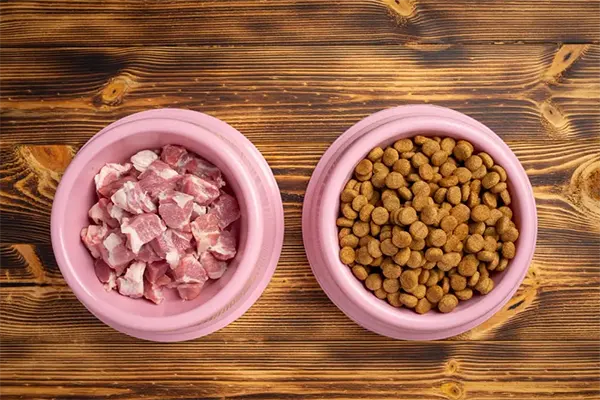Physical Address
304 North Cardinal St.
Dorchester Center, MA 02124
Physical Address
304 North Cardinal St.
Dorchester Center, MA 02124

Keep your Persian cat healthy and happy with the Best Cat Food for Persian Cats! Formulated for digestive care and a beautiful, shiny coat.
Finding the best cat food for Persian cats can be tricky. Persian cats have unique dietary needs. Their long fur and flat faces require specific nutrition. A balanced diet helps maintain their coat, keeps their skin healthy, and ensures they stay active.
With so many options available, knowing what to choose can feel overwhelming. This blog will guide you through the best choices for your Persian cat’s diet. You’ll learn what makes these foods stand out, ensuring your furry friend gets the best care. Let’s explore the top options to keep your Persian cat happy and healthy.

Credit: pawrulz.com
Persian cats, with their luxurious coats and sweet personalities, require specific nutritional care. Their unique physical attributes and predispositions to certain health issues mean they need a balanced diet. Understanding their nutritional needs ensures they stay healthy and happy.
Persian cats need a diet rich in essential nutrients. These nutrients support their long hair, skin health, and overall well-being. Here are some key nutrients:
Persian cats can face several dietary issues. Being aware of these can help in choosing the best cat food for them:
Choosing the right food helps address these common issues. Always consult with a vet for the best dietary plan for your Persian cat.
Choosing the right food for your Persian cat can be challenging. Persian cats have specific dietary needs that can be met with different types of cat food. Understanding these types can help you make the best choice for your furry friend.
Dry food is a popular choice for many cat owners. It is convenient and has a long shelf life. Here are some benefits:
However, dry food has its downsides. Persian cats might find it hard to chew. They have flat faces and small mouths. This can make eating dry food difficult.
Read More: Royal Canin Persian Cat Food
Wet food is another great option for Persian cats. It is moist and flavorful. Here are some benefits:
But, wet food also has some drawbacks. It needs to be refrigerated after opening. It can be more expensive than dry food.
Understanding the types of cat food helps you make an informed decision. Choose the one that best suits your Persian cat’s needs.
Choosing the best cat food for your Persian cat is crucial. Persian cats have specific dietary needs, and the debate between homemade and commercial food is ongoing. Each has its benefits and drawbacks.
Homemade food offers many benefits for Persian cats. One significant advantage is the control over ingredients. You know exactly what your cat is eating.
Homemade food avoids preservatives and fillers. These can sometimes cause allergies or health issues. You can tailor meals to your cat’s specific needs and preferences.
Here are some key benefits:
Another benefit is the quality of nutrients. Fresh ingredients often have more vitamins and minerals. This can boost your cat’s overall health.
Commercial cat food also has several advantages. It is convenient and saves time. You do not need to spend hours preparing meals.
Commercial food is specially formulated to meet dietary standards. This ensures your Persian cat gets balanced nutrition.
Here are some advantages:
Commercial food offers variety. There are many brands and types to choose from. This helps in finding the perfect match for your cat’s taste.
Consistency is another key benefit. Each batch of commercial food has the same quality and taste. This ensures your cat enjoys their meals every time.
Choosing the best cat food for your Persian cat can be challenging. With so many brands on the market, it’s hard to know which one is the best. Persian cats have unique dietary needs due to their long fur and flat faces. They need food that supports their health and keeps their coats shiny. Here are some top commercial cat food brands that meet these needs.
Brand A offers high-quality ingredients. Their formula includes real meat, which is essential for protein. Persian cats thrive on this. It also has added vitamins and minerals. These help support your cat’s overall health. The kibble size is small, making it easy for Persian cats to eat. Many cat owners have noticed improvements in their cat’s coat and energy levels.
Read More: What Meat is Best for Cats?
Brand B is another excellent choice. It features a balanced diet specifically for Persian cats. The main ingredient is chicken, providing necessary protein. It also contains omega-3 and omega-6 fatty acids. These nutrients help maintain a healthy coat and skin. The food is free from artificial colors and preservatives. This makes it a natural and safe option for your cat. Many cats enjoy the taste, making it a favorite among picky eaters.
Choosing the right food for your Persian cat is crucial. These cats need specific nutrients to maintain their health and lush fur. Understanding what to look for in cat food can make this task easier. Here are the key ingredients to consider.
Proteins are essential for Persian cats. Their diet should include high-quality animal proteins. Look for foods with chicken, turkey, or fish as the main ingredient. These proteins support muscle growth and repair. They also help maintain your cat’s energy levels. Avoid plant-based proteins as they are less digestible for cats.
Fats are vital for a Persian cat’s coat and skin. Omega-3 and omega-6 fatty acids are particularly important. These fats help keep the fur shiny and reduce skin irritations. Foods with fish oil or flaxseed oil are good choices. Ensure the food includes a balanced amount of fats to avoid obesity.
Choosing the right cat food for your Persian cat is important. You need to know which ingredients to avoid. Some ingredients can harm your cat’s health. Let’s look at harmful additives and low-quality fillers.
Some cat foods contain harmful additives. These can cause health problems. Avoid foods with artificial colors, flavors, and preservatives. These chemicals can harm your cat’s body.
Low-quality fillers are cheap ingredients. They bulk up the food but offer little nutrition. Avoid these fillers to keep your Persian cat healthy.
| Filler | Why to Avoid |
|---|---|
| Corn | Hard to digest and offers little nutritional value. |
| Wheat | Can cause allergies and digestive issues. |
| Soy | Can disrupt thyroid function and lead to food intolerances. |
Choose cat food with quality ingredients. Avoid these harmful additives and low-quality fillers. This will help your Persian cat stay healthy and happy.
Feeding Persian cats requires special attention to their schedule and portions. Ensuring your cat gets the right amount of food at the right time helps maintain their health and well-being. Read on to learn how to create a feeding routine and control portions for your Persian cat.
A consistent daily feeding routine is crucial for Persian cats. Cats thrive on predictable schedules. Feed your Persian cat twice a day, once in the morning and once in the evening. This helps regulate their metabolism and keeps their energy levels stable throughout the day.
| Time | Meal |
|---|---|
| 8:00 AM | Breakfast |
| 6:00 PM | Dinner |
Ensure that you stick to the same times each day. This helps your cat know when to expect food and reduces anxiety.
Proper portion control prevents overfeeding and obesity. Use the following tips to determine the right portions for your Persian cat:
Read More: Best Cat Food for Mature Indoor Cats
Smaller, more frequent meals can also help in controlling portions. Instead of two large meals, you can split the daily portion into smaller meals fed throughout the day.
Remember to provide fresh water at all times. Proper hydration is just as important as proper nutrition.

Credit: www.reddit.com
Persian cats have unique dietary needs. Their long fur, flat faces, and delicate digestive systems require special attention. It is important to choose the right food. This helps maintain their health and well-being. Here are some key dietary considerations for Persian cats.
Food allergies can be a concern for Persian cats. Common allergens include grains, dairy, and certain proteins. Symptoms may involve itching, digestive issues, and skin problems. Hypoallergenic foods can help manage these issues. Look for limited ingredient diets. These diets often contain novel proteins like duck or venison. This reduces the risk of allergic reactions.
Persian cats can be prone to obesity. Their laid-back nature means they may not be very active. Choosing a low-calorie diet can help manage their weight. Look for foods with high protein and low fat content. This helps maintain muscle mass while reducing calorie intake. Regular portion control is also important. Measure their food to avoid overfeeding.

Credit: www.amazon.in
Wet food with high protein content is best. Persian cats need hydration and quality nutrients.
Feed your Persian cat twice a day. Morning and evening meals are ideal.
Yes, they can eat dry food. But ensure it’s high-quality and supplemented with wet food.
Avoid artificial preservatives, colors, and fillers. Look for natural ingredients and no by-products.
Yes, grain-free food can be good. It reduces the risk of allergies and digestive issues.
Check for natural ingredients, protein sources, and good reviews. Consult your vet for recommendations.
Yes, they need high protein and moisture content. Omega fatty acids support their coat health.
No, avoid human food. It can harm their health. Stick to cat-specific food.
Wet food provides hydration, easier digestion, and better nutrient absorption. Essential for Persian cats.
Gradually mix new food with old. Increase new food amount over 7-10 days. Prevents stomach upset.
Choosing the right food for Persian cats is essential. Their unique needs require special attention. High-quality ingredients support their health and coat. Wet and dry food options both offer benefits. Always check the labels for key nutrients. Consult your vet for personalized advice.
Your Persian cat deserves the best nutrition. Happy and healthy cats make happy owners. Provide them with balanced, nutritious meals.